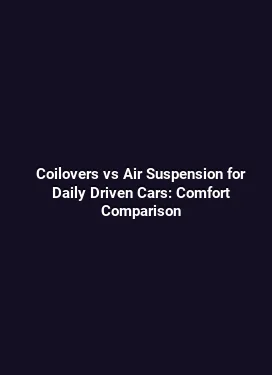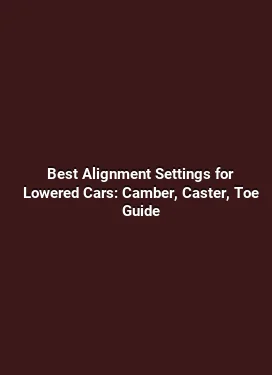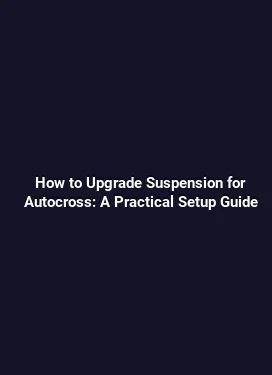BC Racing vs Fortune Auto Coilovers: Budget vs Premium Comparison
In the world of suspension upgrades, coilovers are a focal point for riders seeking improved handling, precise tuning, and a refined daily driving experience. The choice between BC Racing and Fortune Auto coilovers represents a classic budget-conscious versus premium upgrade decision. This analysis delves into real-world performance, adjustability, durability, and tuning pathways to help enthusiasts make an informed selection that aligns with their vehicle, driving style, and maintenance expectations.
Budget versus Premium Coilovers: A Detailed Overview

Coilovers combine shock absorbers and springs into a single assembly that directly affects ride quality, handling response, and body control. Budget-oriented options often prioritize essential damping ranges and durability, while premium offerings emphasize refined valving, progressive spring rates, and advanced alignment and camber capabilities. When evaluating BC Racing against Fortune Auto, several factors emerge as critical to the user experience: seamless adjustability, repeatable performance under varied driving conditions, and long-term reliability that survives spirited street drives as well as occasional track sessions.
Beyond a simple price tag, the decision encompasses daily usability, compatibility with chassis dynamics, and the level of service and calibration support available. Reading the technical nuances of damping curves, rebound control, and spring rates helps translate manufacturer specs into practical results on the road or track. For drivers with aggressive cornering habits, predictable feedback and consistent tire contact with the road surface become the deciding criteria, often tipping the scale toward premium configurations that provide repeatable performance across a wider range of setups.
BC Racing Coilovers: Value, Comfort, and Tuning Potential
BC Racing has built a reputation for offering adjustable coilovers that deliver reliable performance without stepping into the highest price tier. The design philosophy centers on providing a broad adjustment window, robust build quality, and a tuning workflow that accommodates both street and amateur track use. The selection often appeals to drivers who want tangible handling improvements without extensive time spent on complex setup procedures.
In practice, BC Racing coilovers typically present a balanced damping profile that favors mid-range stability and predictable cornering behavior. This makes them approachable for daily drivers who enjoy spirited driving on weekends. The adjustability, including ride height and damping resistance, enables a measurable improvement in body roll management and steering feel once properly tuned. The trade-off often observed is that peak performance under extreme track conditions may not reach the same plateau as premium alternatives, yet the overall experience remains engaging and controllable for a broad audience.
Design Elements and Practical Tuning Steps

The BC Racing lineup commonly features monotube or twin-tube damping architectures, with external reservoirs in some variants to aid heat management during longer sessions. A practical tuning workflow begins with baseline alignment and a conservative spring rate choice aligned with the vehicle’s weight distribution and tire characteristics. Progressive spring rates, when available, help maintain comfort over minor road irregularities while offering stiffer responses during aggressive cornering.
A key advantage for many enthusiasts is the ease of height adjustment. Lowering the ride height often yields improved aerodynamics and reduced squat under acceleration, but it calls for careful toe and camber adjustments to preserve tire contact patterns. For street use, maintaining a comfortable ride while achieving a balanced stance is a core objective; for occasional track days, a few clicks of damping adjustment can sharpen turn-in without compromising stability on cool-down laps.
Fortune Auto Coilovers: Precision Engineering and Track-Ready Tuning
Fortune Auto is widely recognized for high-precision damping programs, refined valve stacks, and a focus on track performance with street usability. The coilovers in this category often appeal to drivers who demand tight control over chassis dynamics, including race-inspired damping profiles, refined low-velocity damping adjustments, and consistent performance under sustained heat exposure. In practical use, Fortune Auto setups tend to deliver immediate, highly predictable response, enabling confident turn-in, flatter cornering, and precise maintaining of tire contact across a broad speed range.
Premium engineering translates into a damping curve that prioritizes stability at high speeds, excellent mid-corner grip, and a resilient feel during abrupt transitions. For track-focused enthusiasts, this translates into repeatable lap times and a more linear response with less drama when encountering mid-corner bumps or off-camber sections. On public roads, Fortune Auto often provides a refined highway ride quality, where the damping rates are tuned to cushion larger road imperfections while preserving steering sensitivity and steering feedback.
Advanced Adjustment Capabilities
Fortune Auto coilovers frequently feature a broader spectrum of adjustability, including refined rebound and compression controls, with easy-to-access external dials or knobs. This level of adjustment allows drivers to tailor the suspension to tire compound, vehicle weight, and track conditions. For example, a driver can soften the compression to improve ride comfort on uneven pavement while maintaining stiff rebound settings for sharper handling balance. The result is a setup that can be dialed in for daily driving and retuned for a competitive track session with minimal disassembly or revalving work.
The company’s attention to damping precision often coincides with high-quality pistons, corrosion-resistant components, and careful assembly tolerances. Such details contribute to consistent performance, especially on hot laps where heat soak can otherwise alter valve behavior. For a lot of users, Fortune Auto’s tuning potential translates into more predictable tire wear patterns and steadier lateral grip, even when approaching the limits of adhesion on a challenging curve set.
Ride Quality, Handling, and Real-World Usability
Both brands aim to improve ride quality and handling, but the path to that goal diverges based on design emphasis. BC Racing tends to offer a favorable balance for daily driving with credible handling improvements. Fortune Auto prioritizes precision and a more aggressive tuning envelope, which benefits drivers who frequently push the car at the limit or who track their vehicle more regularly. The practical impact for owners is a noticeable difference in the way the car responds to steering input, how quickly it settles after a crest or bump, and how evenly the tire maintains contact with the road across conditions.
From a tuning perspective, the ability to tune bump stiffness, rebound, and height adjustments has material consequences on tire contact patch dynamics and load transfer characteristics. For street use, the goal is to reduce excessive body roll without yielding a harsh ride that propagates fatigue. For track use, the objective shifts toward minimizing chassis pitch, keeping tires within their optimal operating window, and ensuring the suspension remains linear and predictable as speeds increase and track surfaces change.
Durability, Maintenance, and Longevity
Durability is a crucial concern for anyone investing in coilovers. Both BC Racing and Fortune Auto emphasize robust materials, high-quality seals, and corrosion-resistant components, but their service approach differs. BC Racing units often benefit from simpler components and easier field maintenance, which translates into lower ongoing maintenance costs and a faster return to service after routine upgrades. Fortune Auto components, while potentially requiring more meticulous maintenance, are designed for harsher use conditions and longer life under track workloads due to higher quality valve trains and better heat management strategies.
Maintenance considerations include regular inspection of springs for sag, checking adjustable collars for thread wear, and ensuring fasteners are torqued to spec after significant height changes. Tire wear is another practical indicator of suspension health; an evenly worn tire surface indicates harmonious load distribution and appropriate alignment, while irregular wear can signal misalignment or improper damping setup. In a well-tuned system, you should notice consistent tire footprint across the width of the contact patch, with minimal cupping or feathering on the shoulders.
Wheel Fitment, Alignment, and Tire Strategy
Adjustable coilovers enable personalized ride height and camber settings, but improper alignment can negate performance gains. Achieving a balanced setup requires attention to alignment, including camber, toe, and caster values, which influence steering feel, tire wear, and straight-line stability. For wheels with aggressive offsets or low-profile tires, precise alignment becomes even more critical, as small misalignments can lead to excessive tire scrub or reduced cornering grip. Both brands encourage owners to invest time in alignment with a trusted technician, especially after height changes or track-driven sessions.
When selecting tires to pair with coilovers, consider tire temperature management and grip curves. Street-legal performance tires will typically respond well to a tuned suspension that prioritizes stability and predictable grip onset. On the other hand, track-focused tires may require stiffer damping settings and more aggressive camber values to maximize contact during hard cornering while avoiding excessive heat buildup in the shoulders.
Installation Considerations and Practical Guidance
Installation quality matters as much as the components themselves. A high-quality coilover kit will require careful preload adjustments, baseline damping configuration, and validated alignment after installation. It is common to need a professional setup session to establish a baseline that matches the vehicle’s weight, tire choice, and driving intentions. Whether opting for BC Racing or Fortune Auto, plan for a diagnostic test drive after installation to confirm that damping and ride height adjustments translate into the expected steering feel and body control across typical road conditions.
Documentation and online resources can assist in selecting appropriate spring rates and damping ranges based on vehicle model and use case. Given the spectrum of driving styles—from daily commuting to weekend track days—the starting point should be conservative with incremental adjustments. Recording each change and its effect on handling, comfort, and tire wear creates a practical reference for future refinements.
Compatibility and Vehicle-Specific Considerations
Both BC Racing and Fortune Auto offer applications for a wide range of vehicles, but compatibility matters. Vehicle weight distribution, chassis construction, and suspension mounting points influence how much benefit a coilover upgrade provides. Some platforms may require additional components such as top mounts, pillow balls, or camber plates to optimize alignment ranges and steering feedback. Before purchasing, verify the exact product fitment for your model year, wheel/tender clearance, and any required subframe or chassis bracing considerations.
Additionally, the intended use—street versus track—should guide the selection. A daily-driven vehicle benefits from a combination of comfort and controllable handling, whereas a track-focused build demands a tighter damping spectrum, heat tolerance, and repeatability under higher load cycles. Understanding the interplay between spring rate, damping pressure, and ride height helps translate specifications into practical, real-world performance improvements.
Key Takeaways: Translating Specifications into Driving Experience
In practical terms, the choice between BC Racing and Fortune Auto coils rests on the balance between affordability, ease of tuning, and the level of performance refinement desired. BC Racing offers solid value with a broad adjustment envelope suitable for a wide range of drivers who want meaningful handling improvements without a steep learning curve. Fortune Auto provides a higher degree of damping precision, broader tuning potential, and a track-oriented performance envelope that benefits enthusiasts who regularly push their vehicles to the limit and demand consistent performance under demanding conditions.
For readers aiming to optimize their setup, begin with a clear objective: identify the primary driving scenario (daily comfort vs track performance), select the appropriate spring rate relative to vehicle weight, and then iterate dampening settings in small increments. Track days or spirited mountain drives benefit from a systematic approach to adjustments, documenting each change to evaluate its impact on steering response, tire wear, and ride quality. In the end, the coilover system should feel like an extension of the chassis—steady, predictable, and compelling across a wide range of speeds and road surfaces.






